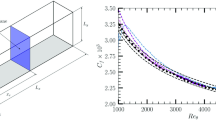Abstract
DNS of turbulent flows is usually performed with high resolution meshes which demand high computational power. In addition, most classic studies use spectral methods due to its accuracy and lack of numerical dissipation. However, the effects of mesh refinement on turbulence structure was not much explored in the literature, mainly when finite volume methods (instead of usual spectral ones) are used to integrate the flow equations. In the present paper, DNS of a single phase channel flow is performed solving the primitive variables in space and time domains, using the Finite Volume Method and its influence on turbulence statistics is analyzed based on four different meshes. The results show some differences in turbulent statistics according to the resolution adopted and confirm that a turbulence analysis can be performed in domains without extreme refinement, at least, for lower order statistics.













Similar content being viewed by others
References
Moser RD, Kim J, Mansour NN (1999) Direct numerical simulation of turbulent channel flow up to Reτ = 590. Phys Fluids 11(4):943–945
Tryggvason G, Esmaeeli A, Lu J, Biswas S (2006) Direct numerical simulations of gas/liquid multiphase flows. Fluid Dyn Res 38(9):660–681
Scardovelli R, Zaleski S (1999) Direct numerical simulation of free-surface and interfacial flow. Annu Rev Fluid Mech 31(1):567–603
Argyropoulos C, Markatos N (2015) Recent advances on the numerical modelling of turbulent flows. Appl Math Model 39(2):693–732
Coleman GN, Sandberg RD (2010) A primer on direct numerical simulation of turbulence-methods, procedures and guidelines—Technical Report AFM-09/01a. Tech. rep., University of Southampton
Patera AT (1984) A spectral element method for fluid dynamics: laminar flow in a channel expansion. J Comput Phys 54(3):468–488
Karniadakis G (1990) Spectral element-Fourier methods for incompressible turbulent flows. Comput Methods Appl Mech Eng 80(1–3):367–380
Vreman A, Kuerten JG (2014) Comparison of direct numerical simulation databases of turbulent channel flow at Reτ = 180. Phys Fluids 26(1):015102
Füle P, Hernádi Z (2014) Investigation of turbulent channel flow using local mesh refinement. Period Polytech Mech Eng 58(1):7–13
Cevheri M, McSherry R, Stoesser T (2016) A local mesh refinement approach for large-eddy simulations of turbulent flows. Int J Numer Methods Fluids 82(5):261–285
Avellaneda J, Bataille F, Toutant A (2019) DNS of turbulent low Mach channel flow under asymmetric high temperature gradient: effect of thermal boundary condition on turbulence statistics. Int J Heat Fluid Flow 77:40–47
Girfoglio M, Quaini A, Rozza G (2019) A finite volume approximation of the Navier–Stokes equations with nonlinear filtering stabilization. Comput Fluids 187:27–45
Majander P, Siikonen T (2002) Evaluation of Smagorinsky-based subgrid-scale models in a finite-volume computation. Int J Numer Methods Fluids 40(6):735–774
Eggels J, Unger F, Weiss M, Westerweel J, Adrian R, Friedrich R, Nieuwstadt F (1994) Fully developed turbulent pipe flow: a comparison between direct numerical simulation and experiment. J Fluid Mech 268:175–210
Iwamoto K, Kasagi N, Suzuki Y (2005) Direct numerical simulation of turbulent channel flow at Reτ = 2320. In: Proceedings of 6th Symp. Smart Control of Turbulence, pp 327–333
Denner F, Evrard F, van Wachem B (2020) Conservative finite-volume framework and pressure-based algorithm for flows of incompressible, ideal-gas and real-gas fluids at all speeds. J Comput Phys 409:109348
Rhie CM, Chow WL (1983) Numerical study of the turbulent flow past an airfoil with trailing edge separation. AIAA J 21(11):1525–1532
Bartholomew P, Denner F, Abdol-Azis MH, Marquis A, van Wachem BG (2018) Unified formulation of the momentum-weighted interpolation for collocated variable arrangements. J Comput Phys 375:177–208
Komen E, Camilo L, Shams A, Geurts BJ, Koren B (2017) A quantification method for numerical dissipation in quasi-DNS and under-resolved DNS, and effects of numerical dissipation in quasi-DNS and under-resolved DNS of turbulent channel flows. J Comput Phys 345:565–595
Kim J, Moin P, Moser R (1987) Turbulence statistics in fully developed channel flow at low Reynolds number. J Fluid Mech 177:133–166
Trofimova AV, Tejada-Martínez AE, Jansen KE, Lahey RT Jr (2009) Direct numerical simulation of turbulent channel flows using a stabilized finite element method. Comput Fluids 38(4):924–938
Rossi R (2009) Direct numerical simulation of scalar transport using unstructured finite-volume schemes. J Comput Phys 228(5):1639–1657
Vinuesa R, Prus C, Schlatter P, Nagib HM (2016) Convergence of numerical simulations of turbulent wall-bounded flows and mean cross-flow structure of rectangular ducts. Meccanica 51(12):3025–3042
Fulgosi M, Lakehal D, Banerjee S, De Angelis V (2003) Direct numerical simulation of turbulence in a sheared air–water flow with a deformable interface. J Fluid Mech 482:319–345
Andrade JR, Martins RS, Thompson RL, Mompean G, da Silveira Neto A (2018) Analysis of uncertainties and convergence of the statistical quantities in turbulent wall-bounded flows by means of a physically based criterion. Phys Fluids 30(4):045106
Bolotnov IA, Jansen KE, Drew DA, Oberai AA, Lahey RT Jr, Podowski MZ (2011) Detached direct numerical simulations of turbulent two-phase bubbly channel flow. Int J Multiph Flow 37(6):647–659
Feng J, Bolotnov IA (2017) Evaluation of bubble-induced turbulence using direct numerical simulation. Int J Multiph Flow 93:92–107
John V, Roland M (2007) Simulations of the turbulent channel flow at Reτ = 180 with projection-based finite element variational multiscale methods. Int J Numer Methods Fluids 55(5):407–429
Pope SB (2001) Turbulent flows. IOP Publishing, Bristol
Moser R, Kim J, Mansour N. DNS data for turbulent channel flow. http://turbulence.oden.utexas.edu/MKM_1999.html. Accessed 20 July 2021
Durran D, Weyn JA, Menchaca MQ (2017) Practical considerations for computing dimensional spectra from gridded data. Mon Weather Rev 145(9):3901–3910
Tennekes H, Lumley JL, Lumley J et al (1972) A first course in turbulence. MIT Press, Cambridge
Acknowledgments
The authors acknowledge the National Laboratory for Scientific Computing (LNCC/MCTI, Brazil) for providing HPC resources of the SDumont supercomputer, which have contributed to the research results reported within this paper.
Author information
Authors and Affiliations
Corresponding author
Additional information
Technical Editor: Daniel Onofre de Almeida Cruz.
Publisher's Note
Springer Nature remains neutral with regard to jurisdictional claims in published maps and institutional affiliations.
Rights and permissions
About this article
Cite this article
de Azevedo, V.W.F., Denner, F., Evrard, F. et al. Performance evaluation of standard second-order finite volume method for DNS solution of turbulent channel flow. J Braz. Soc. Mech. Sci. Eng. 43, 513 (2021). https://doi.org/10.1007/s40430-021-03234-8
Received:
Accepted:
Published:
DOI: https://doi.org/10.1007/s40430-021-03234-8




